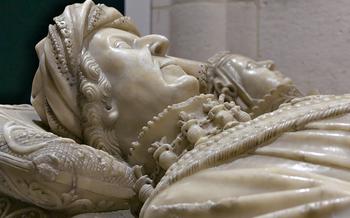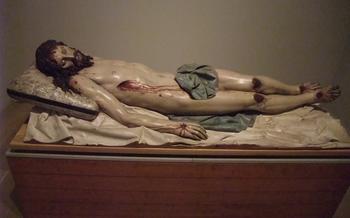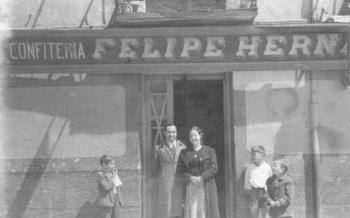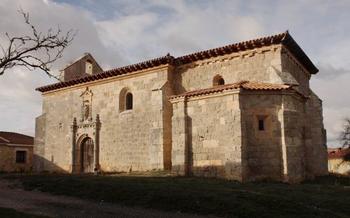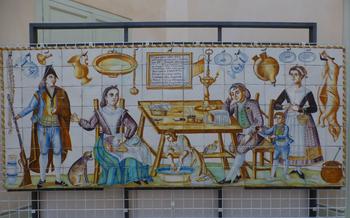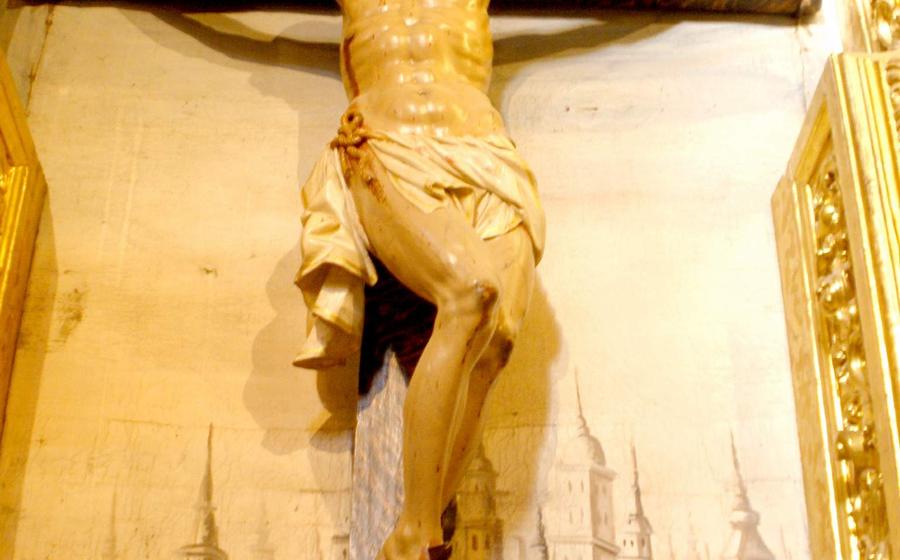
Museo del Retablo
- Burgos' Hidden Gem: Museo del Retablo
- A Journey Through Time: The History of the Museo del Retablo
- Exploring the Collection: Masterpieces of Spanish Art
- The Art of Retablos: A Unique Form of Artistic Expression
- Behind the Scenes: The Conservation and Restoration Process
- Interactive Experiences: Bringing the Past to Life
- Special Exhibitions and Events: A Dynamic Cultural Hub
- Guided Tours: Unveiling the Secrets of the Museo del Retablo
- Research and Scholarship: A Center for Academic Excellence
- Accessibility and Inclusivity: Welcoming All Visitors
- Museo del Retablo Shop: Souvenirs and Treasures
- Planning Your Visit: Essential Information
- Inspiring the Next Generation: Educational Programs for Children
- Insider Tip: Uncovering Hidden Gems
Burgos' Hidden Gem: Museo del Retablo
Nestled in the heart of Burgos, Spain, the Museo del Retablo, or Museum of Altarpieces, stands as a testament to the city's rich artistic and cultural heritage. Founded in 1963, the museum houses an exceptional collection of Spanish altarpieces, offering visitors a breathtaking journey through the history of this unique art form.
The museum's impressive collection showcases over 200 altarpieces, intricately carved and painted by some of Spain's most renowned artists from the 12th to the 18th centuries. Among the highlights are masterpieces by Pedro Berruguete, Alonso de Sedano, and Juan de Juni, whose works exemplify the evolution of retablo art from its Gothic origins to the grandeur of the Renaissance and Baroque periods.
A visit to the Museo del Retablo is not just an artistic experience but also a pilgrimage into the soul of Spain's religious and cultural history. The museum provides a profound understanding of the role that altarpieces played in the lives of Spanish communities, serving as both objects of devotion and symbols of artistic expression. For art and culture enthusiasts, the Museo del Retablo is a hidden gem that promises an unforgettable encounter with the splendor of Spanish heritage.
A Journey Through Time: The History of the Museo del Retablo
the rich artistic heritage of the country. Its origins can be traced back to the early 20th century when a group of art enthusiasts, led by the distinguished scholar Manuel Gómez-Moreno, recognized the need to preserve and showcase Spain's remarkable collection of retablos. These intricately carved and painted altarpieces, once ubiquitous in Spanish churches, were facing neglect and destruction due to changing artistic tastes and the ravages of time.
Fueled by a deep appreciation for this unique art form, Gómez-Moreno and his colleagues embarked on a mission to gather and restore these priceless relics. In 1923, their efforts culminated in the establishment of the Museo del Retablo, which initially occupied a modest space within the city's Museo Arqueológico Provincial. Over the years, the museum's reputation and collection grew, leading to its relocation to a larger and more suitable venue in 195
Today, the Museo del Retablo occupies a former convent, providing a fitting backdrop for its exquisite collection of retablos. The museum's mission to preserve and promote this unique art form has remained unwavering, contributing significantly to the cultural landscape of Burgos and Spain as a whole.
Exploring the Collection: Masterpieces of Spanish Art
The Museo del Retablo showcases a diverse collection of retablos, offering visitors a glimpse into the evolution of Spanish art and religious expression. The museum houses various retablos, ranging from intricate Gothic altarpieces to elaborate Baroque masterpieces.
Among the highlights of the collection is the Retablo Mayor de San Pedro de Cardeña, a stunning Gothic altarpiece created in the 15th century. This monumental work depicts scenes from the life of Christ and the Virgin Mary, rendered in exquisite detail and vibrant colors. The Retablo de Santa Ana, a Renaissance masterpiece by Diego de Siloé, is another must-see. This retablo features a delicate and graceful depiction of the Holy Family, surrounded by intricate carvings and ornamentation.
Visitors can also admire the Retablo de la Transfiguración, a Baroque masterpiece by Gregorio Fernández. This retablo showcases the dramatic moment of Jesus' transfiguration, with expressive figures and dynamic composition. Each retablo in the Museo del Retablo tells a unique story, providing a glimpse into the rich history and artistic traditions of Spain.
The Art of Retablos: A Unique Form of Artistic Expression
Retablos, with their intricate carvings, vibrant colors, and symbolic imagery, are a testament to the skill and artistry of Spanish craftsmen. They were created not only as decorative elements but also as a means of religious expression and storytelling.
The origins of retablos in Spain can be traced back to the Middle Ages, when they were used to adorn churches and chapels. Initially, they were simple wooden structures, but over time, they evolved into elaborate and highly decorated works of art.
Retablos were typically placed behind the altar, serving as a backdrop for religious ceremonies and rituals. They were used to illustrate biblical stories, depict the lives of saints, and honor the Virgin Mary. The use of retablos in religious ceremonies helped to create a sense of awe and devotion among the faithful.
The creation of retablos involved a collaboration between artists, sculptors, and woodworkers. The process began with the design of the retablo, which was often based on sketches or engravings. The retablo was then constructed from wood, and the individual panels were carved with scenes from the Bible or the lives of saints. Once the carving was complete, the retablo was painted and gilded, often with vibrant colors and intricate details.
The symbolism and iconography found in retablos are rich and varied. Each element, from the colors used to the symbols depicted, has a specific meaning and significance. For example, the use of gold leaf represented the divine, while blue was often used to represent the Virgin Mary. The inclusion of certain symbols, such as the cross or the lamb, served to reinforce the religious message of the retablo.
Behind the Scenes: The Conservation and Restoration Process
The Museo del Retablo is not just a place to admire these stunning artworks but also a center for their preservation and restoration. A team of skilled conservators works tirelessly behind the scenes to ensure that these historic pieces remain in pristine condition for generations to come. Using specialized techniques and materials, they carefully clean, repair, and restore damaged retablos, bringing them back to their former glory.
The conservators face various challenges in their work, from addressing the effects of age and wear to dealing with damage caused by insects, water, and improper handling. Each retablo presents its own unique set of problems, requiring a customized approach. The conservators must strike a delicate balance between preserving the original materials and techniques while ensuring the longevity of the artwork.
The process of conservation and restoration is a labor of love and dedication that requires patience, precision, and a deep understanding of the materials and techniques used by the original artists. The conservators at the Museo del Retablo are committed to preserving these precious pieces of Spanish heritage, ensuring that they continue to inspire and captivate visitors for years to come.
Interactive Experiences: Bringing the Past to Life
The Museo del Retablo embraces the power of technology to enhance the visitor experience and bring the past to life. Interactive exhibits invite visitors to explore the world of retablos in new and engaging ways. Touchscreens and multimedia displays provide in-depth information about the history, techniques, and symbolism of these remarkable artworks. Visitors can virtually "step inside" a retablo, examining intricate details and discovering hidden stories. The museum's website offers virtual tours and online resources for those unable to visit in person, ensuring that the museum's treasures are accessible to a global audience. These interactive experiences have proven to be a resounding success, particularly among younger visitors, who are captivated by the opportunity to engage with the museum's collection in a dynamic and immersive way.
Special Exhibitions and Events: A Dynamic Cultural Hub
The Museo del Retablo is not just a repository of historic artworks; it is also a vibrant cultural hub that consistently presents new and exciting exhibitions and events. These events range from temporary exhibitions showcasing the works of contemporary artists to interactive workshops and immersive experiences that bring the past to life.
The museum's commitment to showcasing new and exciting exhibitions is evident in its diverse programming. Recent exhibitions have explored themes such as the influence of Flemish art on Spanish retablos, the role of women in the creation and patronage of religious art, and the evolution of retablos from the Middle Ages to the Baroque period.
In addition to temporary exhibitions, the museum also hosts a variety of special events throughout the year. These events include lectures by renowned art historians, concerts featuring early music ensembles, and family-friendly workshops where visitors can learn about and create their own retablos.
These special exhibitions and events play a crucial role in attracting new visitors to the Museo del Retablo and generating interest in the museum's collection. They also provide a platform for the museum to collaborate with other institutions and organizations to create innovative and engaging experiences for visitors of all ages.
Guided Tours: Unveiling the Secrets of the Museo del Retablo
For a deeper dive into the fascinating world of retablos, guided tours are a must. Conducted in multiple languages, these tours offer a wealth of insights and knowledge that bring the museum's collection to life. Expert guides lead visitors through the galleries, sharing the stories behind the retablos, their artistic significance, and their role in Spanish culture. With their specialized knowledge, guides can point out hidden details and symbolism that might otherwise go unnoticed, enhancing the visitor's appreciation for these exquisite works of art. Whether you're an art enthusiast, a history buff, or simply curious about the rich heritage of Spain, a guided tour of the Museo del Retablo is an unforgettable experience that will leave you with a lasting impression.
Research and Scholarship: A Center for Academic Excellence
The Museo del Retablo is not only a treasure trove of artistic wonders but also a hub for academic research and scholarship. The museum collaborates closely with universities, institutions, and scholars to conduct in-depth studies on retablos and Spanish art. Its extensive library and archives house a wealth of primary sources, rare books, and manuscripts that provide valuable resources for researchers. The museum's commitment to research has led to the publication of scholarly articles, books, and catalogs that contribute to the understanding and appreciation of Spanish artistic heritage. Through its research initiatives, the Museo del Retablo plays a vital role in advancing knowledge and fostering a deeper understanding of the art and culture of Spain.
Accessibility and Inclusivity: Welcoming All Visitors
The Museo del Retablo is committed to providing a welcoming and inclusive environment for all visitors, regardless of their abilities or disabilities. The museum has implemented several measures to ensure accessibility and inclusivity, making it easier for everyone to enjoy the museum's collection and programs.
The museum is fully accessible, with ramps, elevators, and wheelchair-accessible routes throughout the building. Visitors with disabilities can also borrow wheelchairs from the museum's front desk.
The museum offers audio guides in multiple languages, including Spanish, English, French, German, and Italian. These audio guides provide detailed descriptions of the retablos and their history, allowing visitors with visual impairments to fully appreciate the collection.
The museum also offers other assistive devices, such as magnifying glasses and large-print labels, for visitors with low vision. Staff members are always available to assist visitors with disabilities and answer any questions they may have.
The museum's commitment to accessibility and inclusivity extends beyond physical barriers. The museum also offers programs and events that are designed to be inclusive of all visitors, regardless of their background or abilities. For example, the museum offers sensory-friendly tours for visitors with autism or other sensory sensitivities.
The Museo del Retablo is a welcoming and inclusive space where everyone can enjoy and learn from the museum's collection of retablos. The museum's commitment to accessibility ensures that everyone has the opportunity to experience the beauty and history of these remarkable works of art.
Museo del Retablo Shop: Souvenirs and Treasures
The Museo del Retablo houses a gift shop that's a treasure trove of souvenirs and merchandise inspired by the museum's magnificent collection. Here, visitors can find a wide range of items to commemorate their visit to this cultural gem.
From exquisite replicas of retablos to intricate jewelry pieces, the museum shop offers a unique selection of gifts that capture the essence of Spanish art and craftsmanship. Art enthusiasts can find high-quality reproductions of famous retablos, allowing them to take a piece of the museum's beauty home with them.
The shop also features a variety of books, postcards, and other publications that delve deeper into the history and significance of retablos. These items are perfect for those who want to learn more about this fascinating art form or share their newfound knowledge with friends and family.
Proceeds from the museum shop play a vital role in supporting the museum's conservation and educational programs, ensuring that future generations can continue to appreciate and learn from these remarkable artworks. Whether you're looking for a special gift or a unique souvenir, the Museo del Retablo shop is a must-visit for art lovers and history buffs alike.
Planning Your Visit: Essential Information
Before embarking on your journey to the Museo del Retablo, it's essential to plan your visit to make the most of your experience. The museum's hours of operation vary throughout the year, so it's advisable to check their website or contact them directly for the most up-to-date information. Admission fees are typically reasonable, with discounts available for students, seniors, and groups.
To avoid the crowds and ensure a more intimate and enjoyable experience, consider visiting the museum during the off-season or on weekdays. Guided tours are available in multiple languages and provide an excellent opportunity to learn more about the museum and its collection. However, it's essential to book your tour in advance to secure your spot, especially during peak tourist season.
The Museo del Retablo is strategically located in the historic center of Burgos, making it easily accessible on foot or by public transportation. Its proximity to other attractions, such as the Burgos Cathedral and the Plaza Mayor, allows you to combine your visit to the museum with a comprehensive exploration of the city's rich cultural heritage.
Inspiring the Next Generation: Educational Programs for Children
The Museo del Retablo recognizes the importance of introducing children to art and history at an early age. To this end, the museum offers a variety of educational programs specifically designed for children. These programs use interactive activities, games, and storytelling to engage young learners and spark their curiosity about Spanish culture.
One popular program is the "Retablo Adventure," which takes children on a journey through the museum's collection, where they learn about the history, symbolism, and techniques of retablo making. Through hands-on activities and storytelling, children discover the stories behind these sacred artworks and the role they played in Spanish religious and cultural life.
Another program, "Create Your Own Retablo," allows children to express their creativity by designing and creating their own miniature retablos. Using a variety of materials and techniques, children learn about the different elements of a retablo and the artistic choices that go into its creation.
These educational programs are not only fun and engaging for children but also help them develop critical thinking skills, problem-solving abilities, and an appreciation for the beauty and diversity of Spanish art. By fostering a love for Spanish culture among children, the Museo del Retablo is investing in the future of Spain's artistic heritage.
Insider Tip: Uncovering Hidden Gems
Venture beyond the main galleries of the Museo del Retablo to uncover hidden treasures that often go unnoticed by casual visitors. Explore the museum's nooks and crannies, where you might stumble upon a forgotten masterpiece or a captivating story waiting to be discovered.
Seek out the museum's temporary exhibitions, which showcase a diverse range of Spanish art from different periods and styles. These exhibitions offer a fresh perspective on the museum's collection and provide an opportunity to see works that are not usually on display.
Consider joining the museum's membership program to gain exclusive benefits and access to special events. Members receive invitations to private viewings, workshops, and lectures, as well as discounts on museum merchandise and publications.
Engage with the Museo del Retablo's social media platforms for the latest news, updates, and behind-the-scenes glimpses into the museum's activities. Follow the museum on Facebook, Twitter, and Instagram to stay connected and discover new insights into the world of Spanish art.

